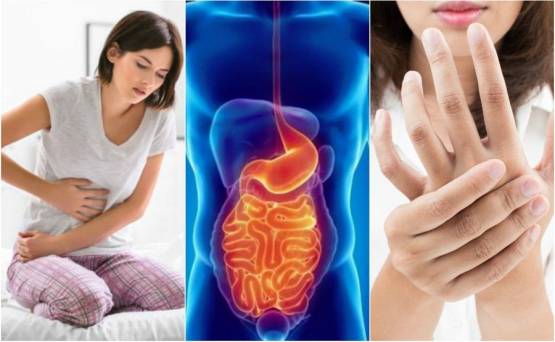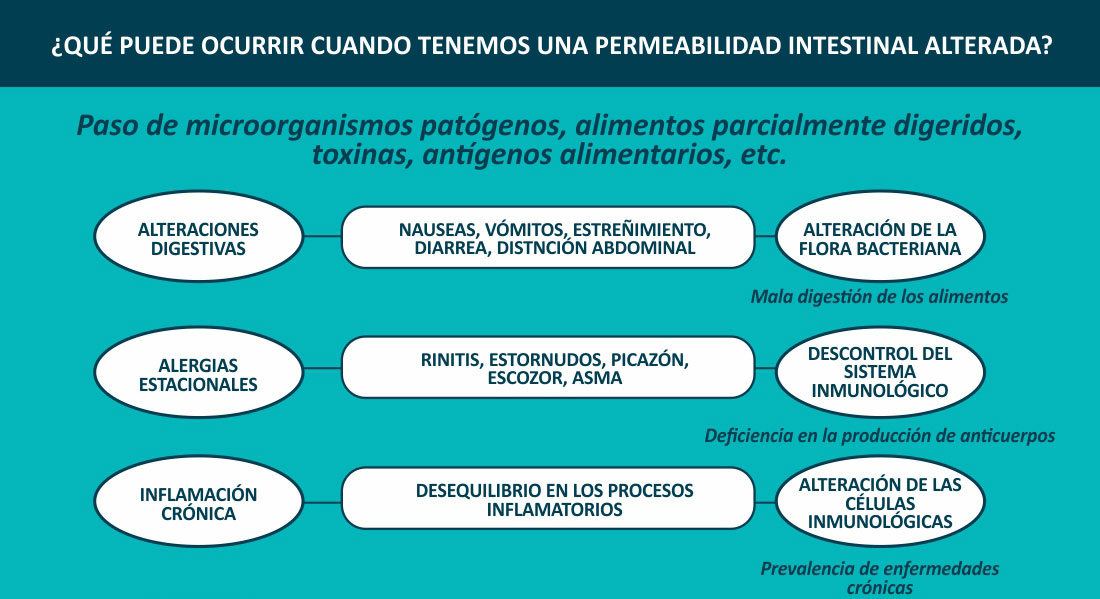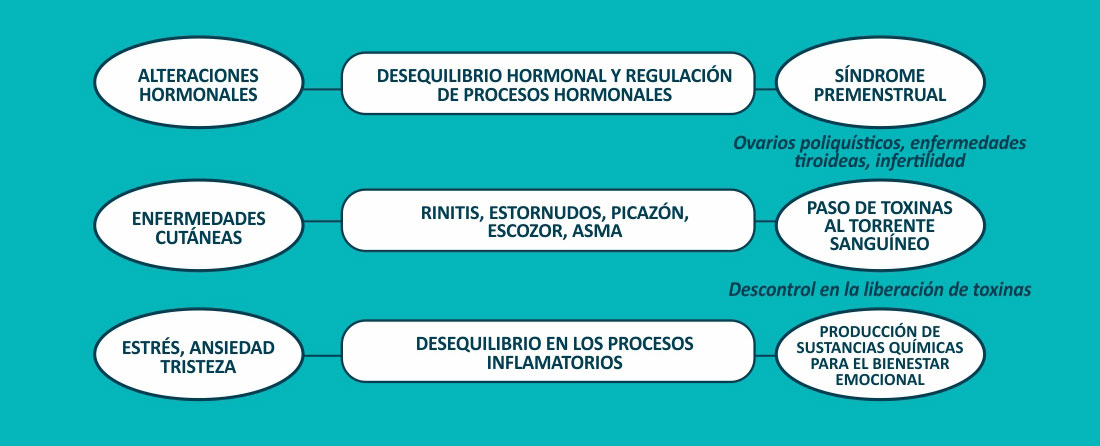PERMEABILIDAD INTESTINAL
La permeabilidad intestinal se entiende como la alteración en la estructura de la pared intestinal, es decir, espacios muy pequeños que permiten la entrada descontrolada de sustancias: toxinas, bacterias, antígenos alimentarios, entre otras, favoreciendo así que estas sustancias pasen a través del torrente sanguíneo a distintos órganos del cuerpo. Cuando esto sucede se produce un aumento de la inflamación y una respuesta inadecuada de nuestro sistema inmunológico.
La permeabilidad intestinal no solo se asocia a problemas en el intestino, sino que también esta implicada en desequilibrios endocrinos como infertilidad y enfermedades tiroideas, en sensibilidades alimentarias, alergias alimentarias, entre otras, entendiendo así, que en este proceso también se produce una alteración inmunoneuroendocrina, existe una estrecha relación en el eje intestino cerebro, es decir, una comunicación bidireccional, cuando se tiene una permeabilidad intestinal alterada se favorece que las sustancias que han entrado en el torrente sanguíneo atraviesen fácilmente la barrera hematoencefálica y lleguen directamente al cerebro generando un desequilibrio en la producción de neurotransmisores, produciendo entre otros una hipersensibilidad.



ARTÍCULOS CIENTÍFICOS
ARTÍCULOS EXTRAIDOS DE SHC MEDICAL
Thevaranjan, N., Puchta, A., Schulz, C., Naidoo, A.,
Szamosi, J. C., Verschoor, C. P., Schertzer, J. D. (2017). Age-associated
microbial dysbiosis promotes intestinal permeability, systemic inflammation,
and macrophage dysfunction. Cell host & microbe, 21(4), 455-466.
Martínez, C., González-Castro, A., Vicario, M.,Santos, J.
(2012). Cellular and molecular basis of intestinal barrier dysfunction in the
irritable bowel syndrome. Gut and liver, 6(3), 305.
Smyth, M. C. (2017). Intestinal permeability and autoimmune
diseases. Bioscience Horizons: The International Journal of Student
Research, 10.
Houser, M. C., Tansey, M. G. (2017). The gut-brain axis: is
intestinal inflammation a silent driver of Parkinson’s disease
pathogenesis. npj Parkinson’s Disease, 3(1), 3.
De Roos, N. M., Van Hemert, S., Rovers, J. M. P., Smits, M.
G., Witteman, B. J. M. (2017). The effects of a multispecies probiotic on
migraine and markers of intestinal permeability–results of a randomized
placebo-controlled study. European journal of clinical nutrition, 71(12),
1455.
Yu-Jie Dai, M. D., Hai-Yan Wang, M. D., Xi-Jian Wang, M. D.,
Alan David Kaye, M. D. (2017). Potential beneficial effects of probiotics on
human migraine headache: a literature review. Pain physician, 20,
E251-E255.
Rahmoune, H., Boutrid, N. (2017). Migraine, Celiac Disease
and Intestinal Microbiota. Pediatric neurology briefs, 31(2), 6.
Wang, J. C., Sung, F. C., Men, M., Wang, K. A., Lin, C. L.,
Kao, C. H. (2017). Bidirectional association between fibromyalgia and
gastroesophageal reflux disease: two population-based retrospective cohort
analysis. Pain, 158(10), 1971-1978.
Ghoshal, U. C., Ghoshal, U. (2017). Small intestinal
bacterial overgrowth and other intestinal disorders. Gastroenterology
Clinics, 46(1), 103-120.
Llewellyn, S. R., Britton, G. J., Contijoch, E. J., Vennaro,
O. H., Mortha, A., Colombel, J. F., Faith, J. J. (2018). Interactions between
diet and the intestinal microbiota alter intestinal permeability and colitis
severity in mice. Gastroenterology, 154(4), 1037-1046.
Rizzetto, L., Fava, F., Tuohy, K. M., Selmi, C. (2018). Connecting the immune
system, systemic chronic inflammation and the gut microbiome: The role of
sex. Journal of autoimmunity.
Little, T. J., Cvijanovic, N., DiPatrizio, N. V., Argueta,
D. A., Rayner, C. K., Feinle-Bisset, C., Young, R. L. (2018). Plasma
endocannabinoid levels in lean, overweight and obese humans: relationships with
intestinal permeability markers, inflammation and incretin secretion. American
Journal of Physiology-Endocrinology and Metabolism.
Ott, B., Skurk, T., Hastreiter, L., Lagkouvardos, I.,
Fischer, S., Büttner, J., Hauner, H. (2017). Effect of caloric restriction on
gut permeability, inflammation markers, and fecal microbiota in obese
women. Scientific Reports, 7(1), 11955.
Nagy-Szakal, D., Barupal, D. K., Lee, B., Che, X., Williams,
B. L., Kahn, E. J., Levine, S. (2018). Insights into myalgic
encephalomyelitis/chronic fatigue syndrome phenotypes through comprehensive
metabolomics. Scientific reports, 8(1), 10056.
Mandarano, A. H., Giloteaux, L., Keller, B. A., Levine, S.
M., Hanson, M. R. (2018). Eukaryotes in the gut microbiota in myalgic
encephalomyelitis/chronic fatigue syndrome. PeerJ, 6, e4282.
Achamrah, N., Déchelotte, P., Coëffier, M. (2017). Glutamine
and the regulation of intestinal permeability: from bench to bedside. Current
Opinion in Clinical Nutrition & Metabolic Care, 20(1), 86-91.
Pugh, J. N., Sage, S., Hutson, M., Doran, D. A., Fleming, S.
C., Highton, J., Close, G. L. (2017). Glutamine supplementation reduces markers
of intestinal permeability during running in the heat in a dose-dependent
manner. European journal of applied physiology, 117(12), 2569-2577.
Kim, M. H., Kim, H. (2017). The roles of glutamine in the
intestine and its implication in intestinal diseases. International
journal of molecular sciences, 18(5), 1051.









